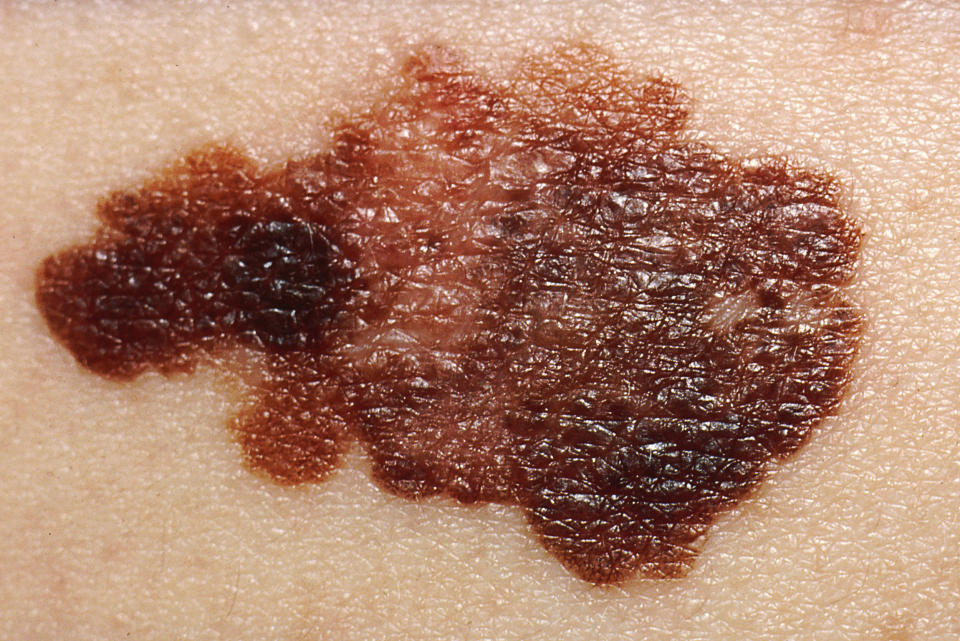Is that mole cancerous? Dermatologists stress what to look out for
Your top layer of skin contains cells, called melanocytes, that create the pigment that gives your skin its color. Melanoma occurs when these cells grow out of control.
You’re a lot less likely to develop melanoma than other types of skin cancers. But melanoma can spread to other parts of the body more easily.
The Skin Cancer Foundation (SCF) predicts that 196,060 people in the U.S. will be diagnosed with melanoma in 2020 — and 6,850 people will die from it.
“It’s the biggie of the skin cancers. It’s the one we’re most worried about — and that’s most scary for most patients,” said Dr. Amy McMichael, chair of the dermatology department at Wake Forest Baptist Health in North Carolina and a member of the American Academy of Dermatology.
Early detection is critical. The SCF recommends an annual skin exam by a dermatologist, and you may need more frequent screening if you are at higher risk. The SCF reports a 99% survival rate for people in the U.S. when melanoma is discovered early, before it spreads to the lymph nodes and other organs.
Symptoms of melanoma
People with light skin, especially if their skin burns easily, are at higher risk for melanoma. But everyone, regardless of skin color, is at risk for this deadly disease. “We see it in patients with darker skin types as well,” said Dr. Ivy Lee, a board-certified dermatologist with Pasadena Premier Dermatology in California and a member of the American Academy of Dermatology.
Since the abnormal cells in melanoma create pigment, most of these tumors are black or brown. The skin cancer symptoms of melanoma can sometimes be pink, tan or white tumors, according to the American Cancer Society (ACS).
They’re often found on the chest and back in men and on the legs in women. People with darker skin are at lower risk of developing melanoma in these places. But melanoma can also appear on the palms, soles, nails and other parts of the body in people with skin of any color. "Melanoma is more common on the hands and feet of patients of African descent," said McMichael.
Causes of melanoma
Ultraviolet light exposure from the sun or from tanning beds causes most melanomas. You’re at higher risk for melanoma if you have a lot of skin moles or if you have larger moles that are an abnormal shape or color.
But if an unusual spot shows up on your skin, get it checked out even if it’s not connected to a mole. The SCF reports that only 20 to 30% of melanomas start at existing moles.
“Be familiar with the constellation that’s on your skin,” Lee said. “You don’t need to memorize every mole or birthmark, but get familiar with the canvas so if anything is new your eye is more attuned to it.”
She said people sometimes think the spot they see on their skin is a new mole, ink mark or bruise, and they delay getting it checked.
It’s important to be on the lookout for signs of cancerous moles. People with a parent, sibling or child with a history of melanoma are at higher risk for the disease, according to the ACS.
McMichael explains that some people have a genetic predisposition to melanoma. “Melanoma is one of those cancers where we are really starting to look at the genetics,” she said.

Diagnosing melanoma
If your dermatologist suspects melanoma, the suspicious area can be biopsied and sent to a lab for examination. If it turns out to be melanoma, your doctor may run blood tests and imaging scans to see how advanced the cancer is — and to grade it.
According to the SCF, melanomas are graded on a scale of 0 to 4, with 4 being the most advanced.
Treatment for melanoma
Treatment for melanoma depends on how advanced it is and where the tumor is located. McMichael said doctors will look at the tumor’s depth, how quickly cells are dividing and other factors to help make treatment decisions.
The SCF says options include:
Surgery
Immunotherapy
Targeted therapy
Chemotherapy
Radiation
Many people with melanoma will see an oncologist and surgical oncologist along with a dermatologist. “This is not one we want to manage alone,” McMichael said.
You can reduce your risk of developing melanoma by reducing your exposure to UV radiation.
The SCF recommends that you:
Cover up with clothing
Stay in the shade, especially between 10 a.m. and 4 p.m.
Use a broad-spectrum sunscreen with an SPF of 15 or higher every day
Use a broad-spectrum, water-resistant sunscreen with an SPF of 30 or higher if you’re going to be out in the sun for a while

